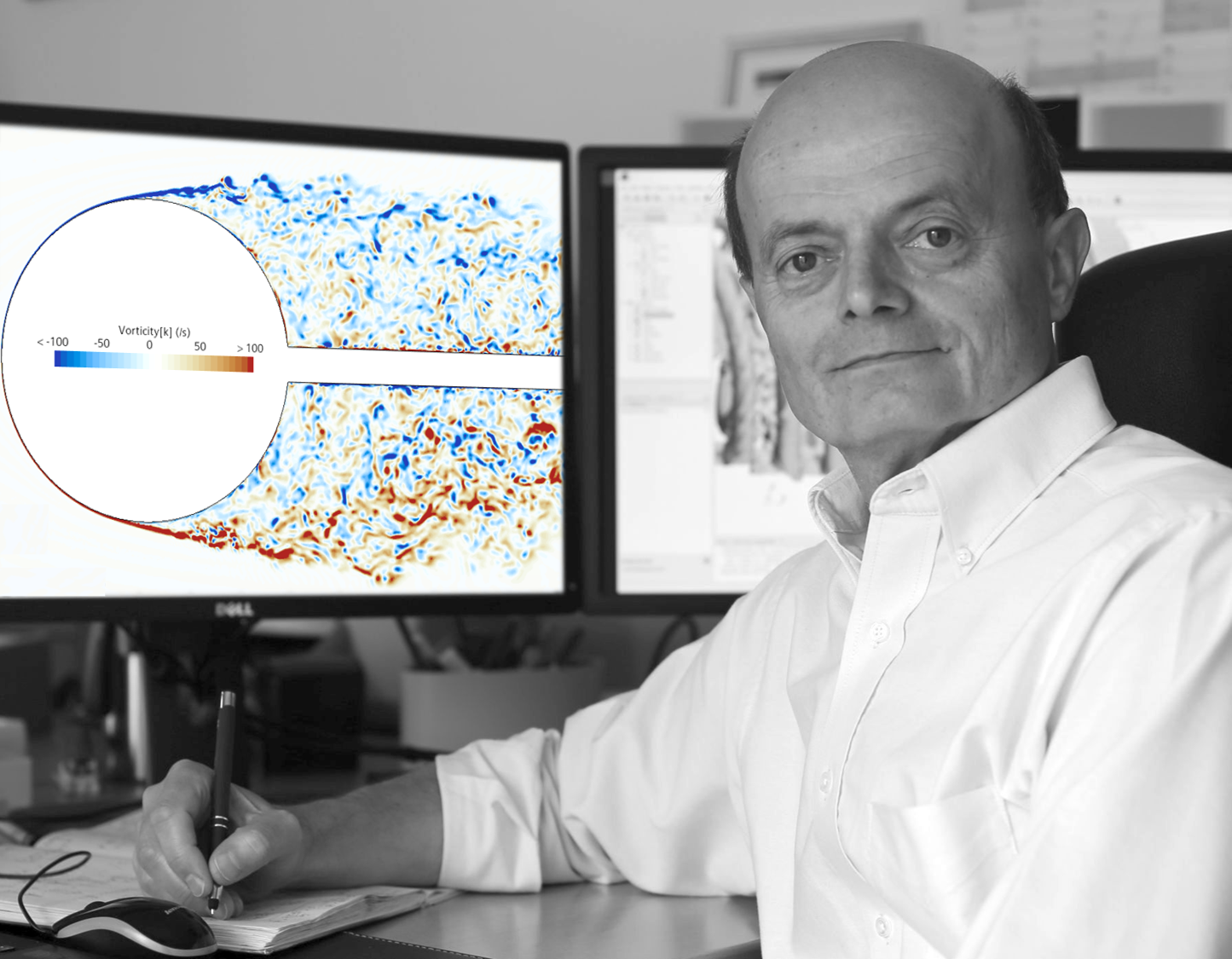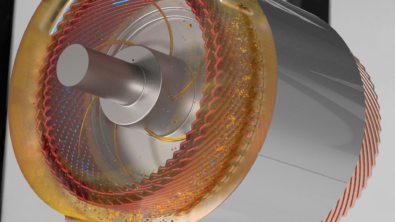The Perić Lectures on CFD: An innovative learning experience

Open-access masterclass in computational fluid dynamics
The purpose of computing is insight, not numbers.
Richard Hamming
In Computational Fluid Dynamics (CFD), this quote by Richard Hamming, a pioneering computer scientist, reminds us that the true value of CFD lies in the understanding and knowledge it provides rather than mere numerical results. This is precisely what The Perić Lectures on CFD aim to deliver – a comprehensive CFD training experience that equips you with the insights and skills to master the art and science of fluid flow simulation.
Led by Professor Milovan Perić and based on the book Computational Methods for Fluid Dynamics by Ferziger, Perić & Street, this course guides you through the vast ocean of CFD—pun intended. It combines theoretical lectures, worked examples, and hands-on simulations, enabling you to grasp complex CFD principles and apply them to real engineering problems.
Perić’s unique approach to learning CFD
What sets The Perić Lectures on CFD apart is its innovative approach to learning. Unlike traditional courses that require formal enrollment, this series combines YouTube videos with a dedicated technical forum where all the course materials are available for download and use (without any registration) in classes and personal research. This synergy creates a unique learning environment that encourages open discussion and collaboration among participants.
To give you a better idea of what to expect, here’s a preview of the course and instructor in this introduction video:
Comprehensive CFD training curriculum
The Perić Lectures on CFD cover a wide range of essential topics, from the fundamentals of fluid dynamics to advanced numerical methods and their implementation. You’ll explore the governing fluid flow equations—the Navier-Stokes equations—and learn how to discretize and solve them using finite-difference and finite-volume methods.
In addition to the fundamental concepts mentioned above, this CFD training covers grid generation, boundary conditions, and solution algorithms, preparing you to solve complex flow problems confidently.
The focus is on presenting fundamental ideas and some of the most widely used methods while pointing toward possible extensions. Key concepts covered include:
- Deriving approximations for derivatives using Taylor series expansion and polynomial fitting
- Determining the order of approximations, both analytically and through specially designed numerical experiments
- Approximating surface, volume, and time integrals
- Interpolating variables on computational grids
Advanced numerical techniques
A major strength of the series is its comprehensive coverage of advanced numerical techniques. You’ll learn about iterative solution methods for linear algebraic equation systems, essential for efficiently solving discretized equations. Techniques covered include conjugate gradient methods for solving large linear systems, multigrid acceleration for speeding up convergence and preconditioning for modifying the linear system.
The curriculum extensively explores higher-order discretization methods up to 4th-order accuracy for both finite-difference and finite-volume approaches. Foundational algorithms, such as SIMPLE and related methods for computing incompressible flows, are also examined. These are widely utilized in commercial CFD codes. Moreover, the course covers Fractional Step Methods, including an innovative implicit version recently introduced.
Practical application and error analysis
The Perić Lectures on CFD also emphasize the importance of error analysis and grid-dependence studies, ensuring that you can assess the accuracy and reliability of your numerical solutions. Through practical examples and hands-on exercises, which highlight both flow physics and the features of the solution methods, you’ll develop an understanding of how grid refinement, discretization schemes, and solution methods impact the quality of your results.
Course structure and resources
From curious students to experienced educators looking to enhance their CFD curriculum, this course offers valuable insights for all levels. The course is structured into two in-depth modules:
- CFD I: Master the fundamentals of CFD in simple geometries using Cartesian grids
- CFD II: Conquer complex geometries and advanced physics modeling
As an open educational resource, this course provides free access to:
- Video lectures by Professor Perić, available on YouTube (see link below)
- Lecture notes (PowerPoint files) and transcripts of the YouTube videos
- Source code for numerical methods
- Simulation files for Simcenter STAR-CCM+
Navigating the CFD training course
To make the most of these resources, follow these steps:
1. Start with chapter one: Begin your journey with the first chapter of the course, which introduces key concepts and principles.
2. Explore the Curriculum: Once you’re comfortable with the basics, browse the full list of available lectures. This will give you an overview of the topics and help you plan your learning path.
3. Dive into Module I and II: Access the detailed content for CFD Module I and the tentative content for CFD Module II to understand CFD fundamentals thoroughly.
4. Engage with the Community: Join the dedicated forum to connect with fellow learners and CFD enthusiasts. You can share projects, discuss challenges, and exchange ideas, enhancing your learning through peer interaction.
The Perić Lectures offer a fresh take on CFD education. By combining video lectures with an active forum, the course creates a unique learning environment. Students watch complex fluid dynamics concepts unfold visually and discuss real-world applications with peers immediately after. This mix of visual learning and collaborative problem-solving helps develop a more intuitive understanding of CFD principles.
Global accessibility and language support
One of the features of The Perić Lectures on CFD is its commitment to global accessibility. Recognizing that language barriers can hinder learning in many parts of the world, the course materials are designed with translation in mind. This approach is particularly beneficial for educators and students in regions where English is not the primary language of instruction.
Instructors can leverage AI translation tools to adapt both PowerPoint presentations and audio transcripts from the video lectures. This flexibility allows teachers, mutatis mutandis, to create CFD training courses in their native languages, making the content more accessible and easier for their students to understand. By offering this possibility, The Perić Lectures on CFD aim to break down language barriers and democratize access to high-quality CFD education worldwide.
To fully benefit from the course materials, including simulation files, educators and students will need access to Simcenter STAR-CCM+. Affordable licenses for educational purposes are readily available.
Conclusion
One of Richard Feynman’s most famous quotes found written on his blackboard after his death, states: ‘What I cannot create, I do not understand.’ The Perić Lectures on CFD embody this philosophy, empowering you to comprehend and innovate in computational fluid dynamics. By engaging with this comprehensive CFD training and learning directly from Professor Perić’s decades of experience, you’ll gain unique insights and practical skills that will distinguish you in this rapidly evolving field.
Additional ressources
For those interested in expanding their CFD knowledge further, consider exploring Coursera’s Applied Computational Fluid Dynamics course.
The Siemens Community page features a technical forum for discussions and collaboration among Computational Fluid Dynamics practitioners.
Get to know your teacher and learn from inspiring insights of a career dedicated to CFD. Watch Milovan Perić’ as a guest on Jousef Murad’s Engineered Mind podcast episode #100:


